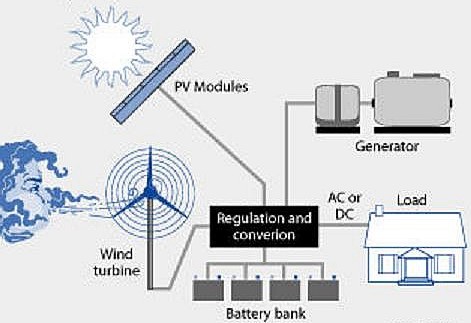 The
nearest grid power to the house is over 6 miles away and it would cost $60,000
to run a line! Not that it makes a difference as we want to be self sufficient
for power.
The
nearest grid power to the house is over 6 miles away and it would cost $60,000
to run a line! Not that it makes a difference as we want to be self sufficient
for power.
So the diagram to the right shows the components we will be using
for power. Of course in sunny Arizona photovoltaic cells will be the primary
power source, but for those stormy days when sunlight is low a wind turbine will
provide a secondary source. As with all systems there is a back-up in the form
of a propane generator. Propane being preferred as it is less polluting than
diesel or petroleum.
All power sources connect to a regulator that charges the
battery bank and if needed will automatically turn on the generator. The
regulator also has a built in inverter that converts the DC current of the
batteries to AC for use in the house.
The challenge in designing the system is having good estimates on how much
power we will need, and how much generating capacity will be needed to meet that
need. The battery pack must be sufficient to power the house through periods
when generation is low. The temptation is to over design the system, but the
costs can climb rapidly. Some of the new regulators come with
communication ports that allow a computer to track the performance of the
system. So with this facility we intend to design the system closer to the
estimated requirements and accept that the generator may be used more frequently
in the earlier days. Analysis of the performance data will then allow us to add
additional PV modules to match our loads more accurately.
This is a interesting time to be entering this technology as there has
recently been several break troughs in the field and costs of components are
reducing. We will be looking at some of these innovations in other pages.
The system can be made more efficient by reducing the power budget by
using energy efficient appliances. (More annon)
